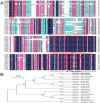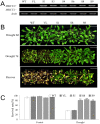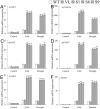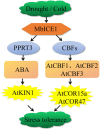MbICE1 Confers Drought and Cold Tolerance through Up-Regulating Antioxidant Capacity and Stress-Resistant Genes in Arabidopsis thaliana
- PMID: 36555710
- PMCID: PMC9783906
- DOI: 10.3390/ijms232416072
MbICE1 Confers Drought and Cold Tolerance through Up-Regulating Antioxidant Capacity and Stress-Resistant Genes in Arabidopsis thaliana
Abstract
Malus baccata (L.) Borkh is an apple rootstock with good drought and cold resistance. The ICE gene is a key factor in the molecular mechanisms of plant drought and cold resistance. In the present research, the function of drought- and cold-induced MbICE1 of Malus baccata was investigated in Arabidopsis. According to GFP fluorescence images, MbICE1 was determined to be a nuclear protein. The MbICE1 was transferred to Arabidopsis, showing enhanced tolerance to drought and cold stresses. Under drought and cold treatments, the transgenic Arabidopsis had higher chlorophyll content and free proline content than WT plants, but the Malondialdehyde (MDA) content and electrolyte leakage (EL) were lower than those of WT plants. In addition, drought and cold led to a large accumulation of ROS (H2O2 and O2-) content in Arabidopsis, while overexpression of MbICE1 enhanced the antioxidant enzyme activity in Arabidopsis and improved the plant's resistance to stresses. Moreover, the accumulation of MbICE1 promoted the expression of AtCBF1, AtCBF2, AtCBF3, AtCOR15a, AtCOR47 and AtKIN1 genes in Arabidopsis. These data indicate that MbICE1 is a key regulator of drought and cold and can be used as a backup gene for breeding Malus rootstocks.
Keywords: Malus baccata (L.) Borkh; MbICE1; cold stress; drought stress.
Conflict of interest statement
The authors declare no conflict of interest.
Figures










Similar articles
-
Overexpression of a Malus baccata MYB Transcription Factor Gene MbMYB4 Increases Cold and Drought Tolerance in Arabidopsis thaliana.Int J Mol Sci. 2022 Feb 4;23(3):1794. doi: 10.3390/ijms23031794. Int J Mol Sci. 2022. PMID: 35163716 Free PMC article.
-
Molecular Cloning and Characterization of MbMYB108, a Malus baccata MYB Transcription Factor Gene, with Functions in Tolerance to Cold and Drought Stress in Transgenic Arabidopsis thaliana.Int J Mol Sci. 2022 Apr 27;23(9):4846. doi: 10.3390/ijms23094846. Int J Mol Sci. 2022. PMID: 35563237 Free PMC article.
-
Overexpression of a Malus baccata NAC Transcription Factor Gene MbNAC25 Increases Cold and Salinity Tolerance in Arabidopsis.Int J Mol Sci. 2020 Feb 11;21(4):1198. doi: 10.3390/ijms21041198. Int J Mol Sci. 2020. PMID: 32054040 Free PMC article.
-
MbWRKY53, a M. baccata WRKY Transcription Factor, Contributes to Cold and Drought Stress Tolerance in Transgenic Arabidopsis thaliana.Int J Mol Sci. 2024 Jul 11;25(14):7626. doi: 10.3390/ijms25147626. Int J Mol Sci. 2024. PMID: 39062869 Free PMC article.
-
The Kandelia obovata transcription factor KoWRKY40 enhances cold tolerance in transgenic Arabidopsis.BMC Plant Biol. 2022 Jun 4;22(1):274. doi: 10.1186/s12870-022-03661-2. BMC Plant Biol. 2022. PMID: 35659253 Free PMC article.
Cited by
-
The Transcription Factor MbWRKY46 in Malus baccata (L.) Borkh Mediate Cold and Drought Stress Responses.Int J Mol Sci. 2023 Aug 5;24(15):12468. doi: 10.3390/ijms241512468. Int J Mol Sci. 2023. PMID: 37569844 Free PMC article.
-
Salt gradient-driven adaptation in okra: uncovering mechanisms of tolerance and growth regulation.Front Plant Sci. 2025 Jul 23;16:1648092. doi: 10.3389/fpls.2025.1648092. eCollection 2025. Front Plant Sci. 2025. PMID: 40772056 Free PMC article.
-
Genome-Wide Identification of Freezing-Responsive Genes in a Rapeseed Line NTS57 Tolerant to Low-Temperature.Int J Mol Sci. 2024 Nov 21;25(23):12491. doi: 10.3390/ijms252312491. Int J Mol Sci. 2024. PMID: 39684201 Free PMC article.
-
Characterization of Critical Amino Acids in the Transport and Selectivity of the Plant Na+/H+ Exchanger Plasma Membrane SOS1.Int J Mol Sci. 2025 Apr 9;26(8):3518. doi: 10.3390/ijms26083518. Int J Mol Sci. 2025. PMID: 40332001 Free PMC article.
-
GWAS and transcriptome analyses unravel ZmGRAS15 regulates drought tolerance and root elongation in maize.BMC Genomics. 2025 Mar 13;26(1):246. doi: 10.1186/s12864-025-11435-x. BMC Genomics. 2025. PMID: 40082805 Free PMC article.
References
MeSH terms
Substances
Grants and funding
- 2022YFD1600502/the National Key Research and Development Program of China
- 32172521/the National Natural Science Foundation of China
- HNK2019CX11-6-1/Heilongjiang Academy of Agricultural Sciences "Agricultural Science and Technology Innovation Spanning Project" special
- 2020FJZX054 and 2020YYY001/the Heilongjiang Academy of Agricultural Sciences "Youth Science Fund Project" special
LinkOut - more resources
Full Text Sources

